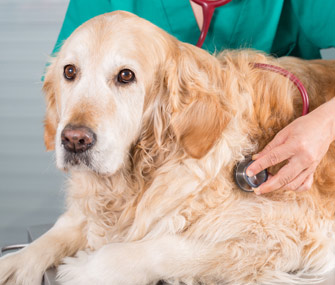An Update on Canine Lymphoma Treatment
Published on April 20, 2017

If you have the unfortunate opportunity to spend time in a veterinary oncologist’s waiting room and decide to strike up a conversation with other pet families, you will discover that many of the dog patients likely are being treated for lymphoma. What is this common disease and how do veterinary oncologists treat it?
Not Just Lymph Nodes
Lymphoma is considered a malignant cancer affecting cells of the lymphatic or immune system. In dogs, the disease most commonly occurs in the lymph nodes — little bean-shaped structures filled with lymphocytes or immune cells. Lymph nodes are found behind the knees, under the chin, in the armpits and elsewhere. But since the immune system is distributed throughout the body, lymphoma can be found just about anywhere, including in internal lymph nodes, the skin, lungs and abdominal organs. If your dog develops lymphoma, you might notice enlarged lymph nodes during a petting session. Or your dog might have a red rash or a case of bad diarrhea, because the skin and intestines are two organs affected by this type of cancer.
Not Just One Disease
The immune system is a complicated organ system, scattered throughout the body. It helps protect and defend the body against disease-causing organisms like viruses, bacteria and fungi. The expansive functions of the immune system require it to produce dozens of different types of immune cells, and a different lymphoma variant can arise from each type of immune cell. Based on biopsy results, pathologists have identified more than 30 different varieties of lymphoma in dogs. Each variety carries its own prognosis and has a preferred treatment. The most common form of canine lymphoma, diffuse large B cell lymphoma, is treated with chemotherapy.
One Drug Regimen
For some dogs and their families, a simple lymphoma treatment with one drug makes the most sense. Prednisone, an inexpensive steroid that is administered orally under the direction of a veterinarian, kills lymphoma cells and can sometimes induce remission. However, prednisone’s impact is short-lived and remission typically lasts only a couple of months. Doxorubicin, an intravenously administered chemotherapy drug, can be effective in inducing remission in 80 to 90% of dogs receiving this treatment. Successful therapy with this drug typically results in a median survival time of more than 9 to 10 months, which means half the patients treated in this way will still be alive at that time.
Human Drugs Gone to the Dogs
The current state-of-the-art of treatment for many forms of canine lymphoma is a modification of the chemotherapy protocol used to treat humans with the disease. The protocol uses a combination of the same four drugs used in humans, although at dog-appropriate dosages and on a different treatment schedule. This regimen results in the longest median survival time for dogs with lymphoma, with a median survival time of about 12 months from the time of diagnosis. About 20% of dogs will live more than two years. The prescribed treatment course is approximately six months long and includes prednisone and doxorubicin, among other drugs. The four-drug combination may not suit all patient families or budgets and so it is not universally prescribed for all dogs with lymphoma.
In Rare Cases, No Treatment Needed
Most lymphomas need treatment, but in a small number of cases, this may not be true. Veterinary oncologists and pathologists who have studied canine lymphoma have identified forms of the disease with an ‘indolent course.’ These forms of lymphoma are slow to progress and do not typically cause clinical signs. However, these forms are uncommon. The trick is for your veterinarian to parse the biopsy report carefully and determine if your dog is one of the rare lucky dogs with one of these rare forms of lymphoma that need close monitoring but no chemotherapy.
No Surgery? No Radiation?
For most types of cancer, surgery is the mainstay of treatment, but lymphoma is different. In many dogs, a lymphoma diagnosis is based on a needle aspirate. In other dogs, surgery might be used to obtain a biopsy, but oncologists infrequently use it as a treatment. Think about it: Surgery can easily remove a solitary lump or bump, but since lymphoma involves the entire immune system, which is dispersed throughout the body, even the best surgeon in the world would not be able to remove every speck of cancer. Similarly, radiation therapy is rarely used in the treatment of canine lymphoma, unless the disease appears to be in just one location. However, if radiation therapy is used, a course of chemotherapy is also typically administered. While dog families might be concerned about chemotherapy, veterinary oncologists know just the right dose and regimen to keep patients free of major chemotherapy side effects.
A Drug Just for Dogs
Until now, all the drugs used by veterinary oncologists to treat canine lymphoma were adopted human lymphoma drugs. Recently, however, the FDA approved rabacfosadine, the first drug specifically for the treatment of lymphoma in dogs. Dr. Brenda Phillips, a board certified veterinary oncologist in San Diego, was one of the investigators involved in the clinical trials that led to approval of this new drug. Dr. Phillips’ comments probably sum up the opinion of many veterinarians with lymphoma patients when she points out that, “I for one, am very excited that Tanovea™-CA1 (the trade name of the new drug) will soon be available for the treatment of canine lymphoma. Veterinarians can prescribe the drug as first-line chemotherapy or in dogs with relapsed lymphoma.” The drug, which must be administered intravenously, is now available to veterinarians who treat lymphoma and will be an important advance both for dogs suffering from lymphoma and their families. Veterinary oncologists like myself anticipate that having an additional drug that’s effective against lymphoma will improve survival times and keep dogs and their families together longer.
More on Vetstreet:





